Consumer Behavior and Marketing Psychology: A Case Study of Starbucks
VerifiedAdded on 2023/06/05
|13
|3463
|263
AI Summary
This case study analyzes Starbucks' marketing strategy and communication mix, and provides strategic recommendations for the company's board of directors to remain competitive. The report includes a product overview, critical analysis, and consumer behavioral factors in making a purchase.
Contribute Materials
Your contribution can guide someone’s learning journey. Share your
documents today.
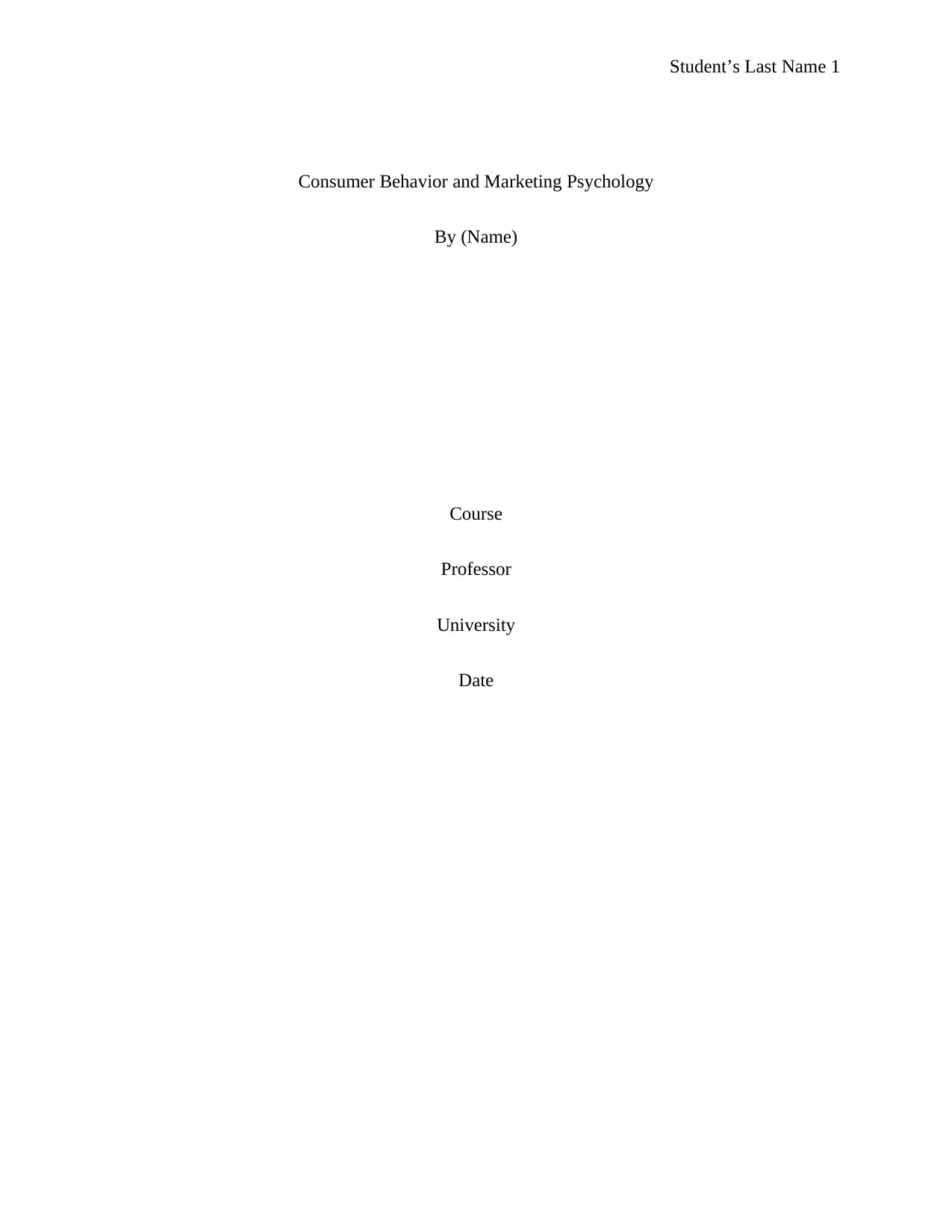
Student’s Last Name 1
Consumer Behavior and Marketing Psychology
By (Name)
Course
Professor
University
Date
Consumer Behavior and Marketing Psychology
By (Name)
Course
Professor
University
Date
Secure Best Marks with AI Grader
Need help grading? Try our AI Grader for instant feedback on your assignments.
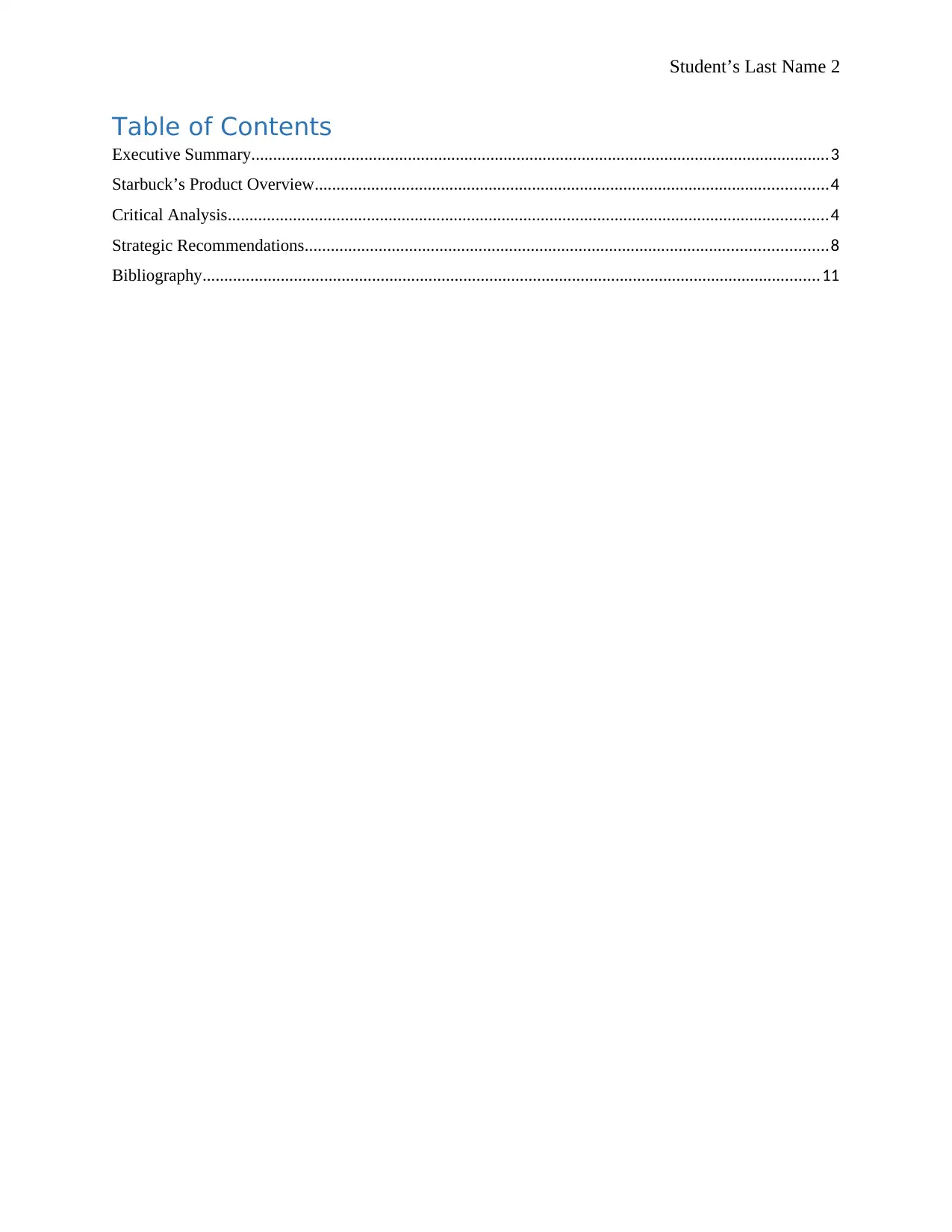
Student’s Last Name 2
Table of Contents
Executive Summary.....................................................................................................................................3
Starbuck’s Product Overview......................................................................................................................4
Critical Analysis..........................................................................................................................................4
Strategic Recommendations........................................................................................................................8
Bibliography..............................................................................................................................................11
Table of Contents
Executive Summary.....................................................................................................................................3
Starbuck’s Product Overview......................................................................................................................4
Critical Analysis..........................................................................................................................................4
Strategic Recommendations........................................................................................................................8
Bibliography..............................................................................................................................................11
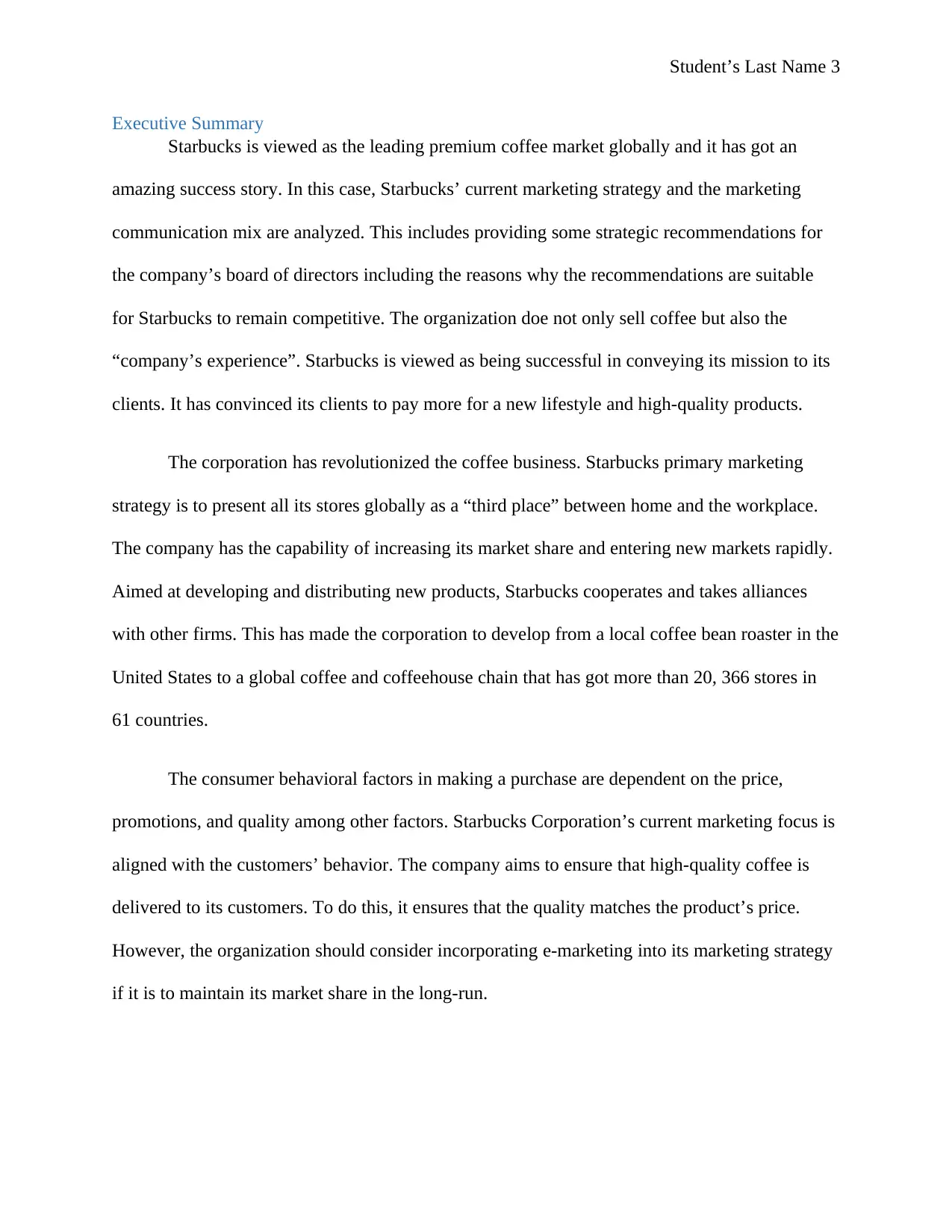
Student’s Last Name 3
Executive Summary
Starbucks is viewed as the leading premium coffee market globally and it has got an
amazing success story. In this case, Starbucks’ current marketing strategy and the marketing
communication mix are analyzed. This includes providing some strategic recommendations for
the company’s board of directors including the reasons why the recommendations are suitable
for Starbucks to remain competitive. The organization doe not only sell coffee but also the
“company’s experience”. Starbucks is viewed as being successful in conveying its mission to its
clients. It has convinced its clients to pay more for a new lifestyle and high-quality products.
The corporation has revolutionized the coffee business. Starbucks primary marketing
strategy is to present all its stores globally as a “third place” between home and the workplace.
The company has the capability of increasing its market share and entering new markets rapidly.
Aimed at developing and distributing new products, Starbucks cooperates and takes alliances
with other firms. This has made the corporation to develop from a local coffee bean roaster in the
United States to a global coffee and coffeehouse chain that has got more than 20, 366 stores in
61 countries.
The consumer behavioral factors in making a purchase are dependent on the price,
promotions, and quality among other factors. Starbucks Corporation’s current marketing focus is
aligned with the customers’ behavior. The company aims to ensure that high-quality coffee is
delivered to its customers. To do this, it ensures that the quality matches the product’s price.
However, the organization should consider incorporating e-marketing into its marketing strategy
if it is to maintain its market share in the long-run.
Executive Summary
Starbucks is viewed as the leading premium coffee market globally and it has got an
amazing success story. In this case, Starbucks’ current marketing strategy and the marketing
communication mix are analyzed. This includes providing some strategic recommendations for
the company’s board of directors including the reasons why the recommendations are suitable
for Starbucks to remain competitive. The organization doe not only sell coffee but also the
“company’s experience”. Starbucks is viewed as being successful in conveying its mission to its
clients. It has convinced its clients to pay more for a new lifestyle and high-quality products.
The corporation has revolutionized the coffee business. Starbucks primary marketing
strategy is to present all its stores globally as a “third place” between home and the workplace.
The company has the capability of increasing its market share and entering new markets rapidly.
Aimed at developing and distributing new products, Starbucks cooperates and takes alliances
with other firms. This has made the corporation to develop from a local coffee bean roaster in the
United States to a global coffee and coffeehouse chain that has got more than 20, 366 stores in
61 countries.
The consumer behavioral factors in making a purchase are dependent on the price,
promotions, and quality among other factors. Starbucks Corporation’s current marketing focus is
aligned with the customers’ behavior. The company aims to ensure that high-quality coffee is
delivered to its customers. To do this, it ensures that the quality matches the product’s price.
However, the organization should consider incorporating e-marketing into its marketing strategy
if it is to maintain its market share in the long-run.
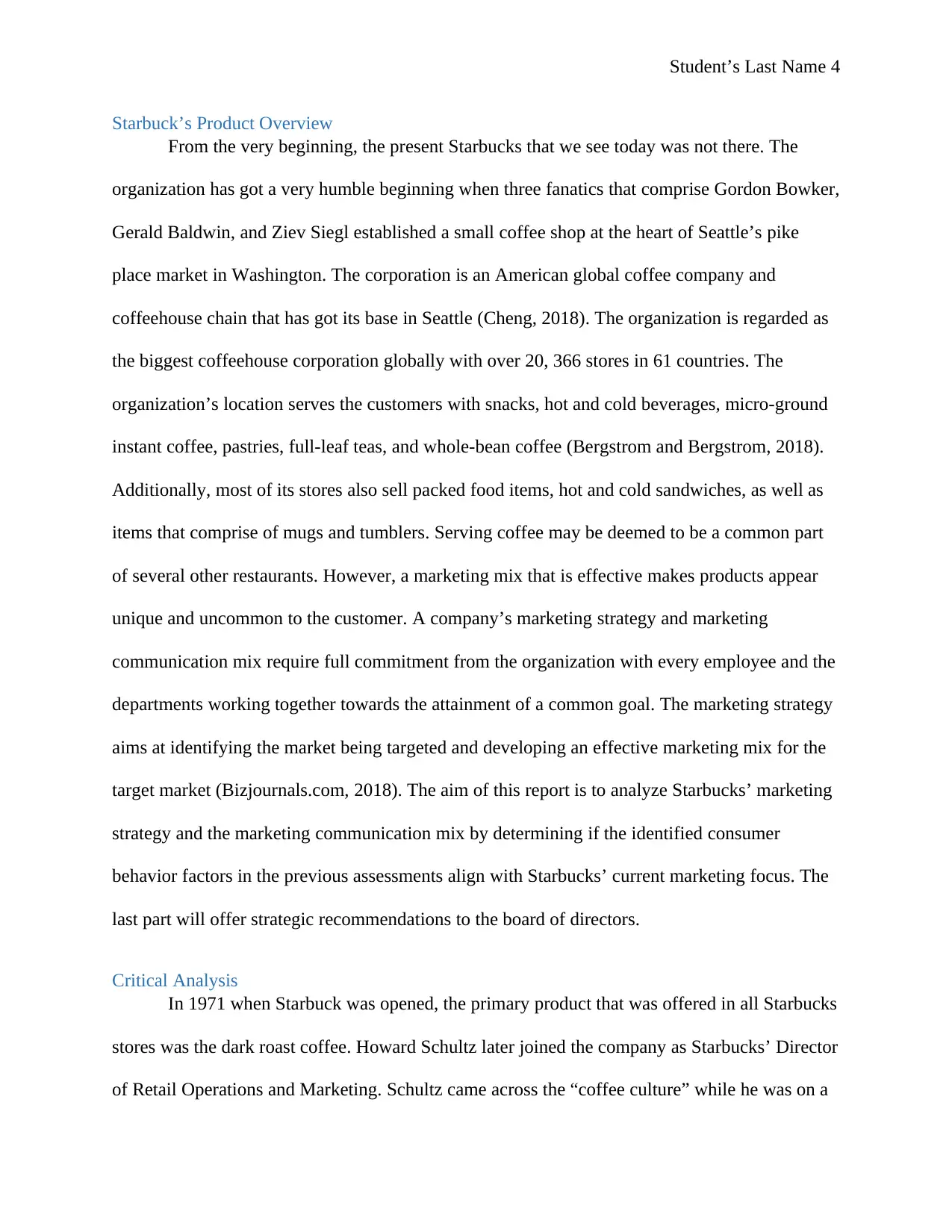
Student’s Last Name 4
Starbuck’s Product Overview
From the very beginning, the present Starbucks that we see today was not there. The
organization has got a very humble beginning when three fanatics that comprise Gordon Bowker,
Gerald Baldwin, and Ziev Siegl established a small coffee shop at the heart of Seattle’s pike
place market in Washington. The corporation is an American global coffee company and
coffeehouse chain that has got its base in Seattle (Cheng, 2018). The organization is regarded as
the biggest coffeehouse corporation globally with over 20, 366 stores in 61 countries. The
organization’s location serves the customers with snacks, hot and cold beverages, micro-ground
instant coffee, pastries, full-leaf teas, and whole-bean coffee (Bergstrom and Bergstrom, 2018).
Additionally, most of its stores also sell packed food items, hot and cold sandwiches, as well as
items that comprise of mugs and tumblers. Serving coffee may be deemed to be a common part
of several other restaurants. However, a marketing mix that is effective makes products appear
unique and uncommon to the customer. A company’s marketing strategy and marketing
communication mix require full commitment from the organization with every employee and the
departments working together towards the attainment of a common goal. The marketing strategy
aims at identifying the market being targeted and developing an effective marketing mix for the
target market (Bizjournals.com, 2018). The aim of this report is to analyze Starbucks’ marketing
strategy and the marketing communication mix by determining if the identified consumer
behavior factors in the previous assessments align with Starbucks’ current marketing focus. The
last part will offer strategic recommendations to the board of directors.
Critical Analysis
In 1971 when Starbuck was opened, the primary product that was offered in all Starbucks
stores was the dark roast coffee. Howard Schultz later joined the company as Starbucks’ Director
of Retail Operations and Marketing. Schultz came across the “coffee culture” while he was on a
Starbuck’s Product Overview
From the very beginning, the present Starbucks that we see today was not there. The
organization has got a very humble beginning when three fanatics that comprise Gordon Bowker,
Gerald Baldwin, and Ziev Siegl established a small coffee shop at the heart of Seattle’s pike
place market in Washington. The corporation is an American global coffee company and
coffeehouse chain that has got its base in Seattle (Cheng, 2018). The organization is regarded as
the biggest coffeehouse corporation globally with over 20, 366 stores in 61 countries. The
organization’s location serves the customers with snacks, hot and cold beverages, micro-ground
instant coffee, pastries, full-leaf teas, and whole-bean coffee (Bergstrom and Bergstrom, 2018).
Additionally, most of its stores also sell packed food items, hot and cold sandwiches, as well as
items that comprise of mugs and tumblers. Serving coffee may be deemed to be a common part
of several other restaurants. However, a marketing mix that is effective makes products appear
unique and uncommon to the customer. A company’s marketing strategy and marketing
communication mix require full commitment from the organization with every employee and the
departments working together towards the attainment of a common goal. The marketing strategy
aims at identifying the market being targeted and developing an effective marketing mix for the
target market (Bizjournals.com, 2018). The aim of this report is to analyze Starbucks’ marketing
strategy and the marketing communication mix by determining if the identified consumer
behavior factors in the previous assessments align with Starbucks’ current marketing focus. The
last part will offer strategic recommendations to the board of directors.
Critical Analysis
In 1971 when Starbuck was opened, the primary product that was offered in all Starbucks
stores was the dark roast coffee. Howard Schultz later joined the company as Starbucks’ Director
of Retail Operations and Marketing. Schultz came across the “coffee culture” while he was on a
Secure Best Marks with AI Grader
Need help grading? Try our AI Grader for instant feedback on your assignments.
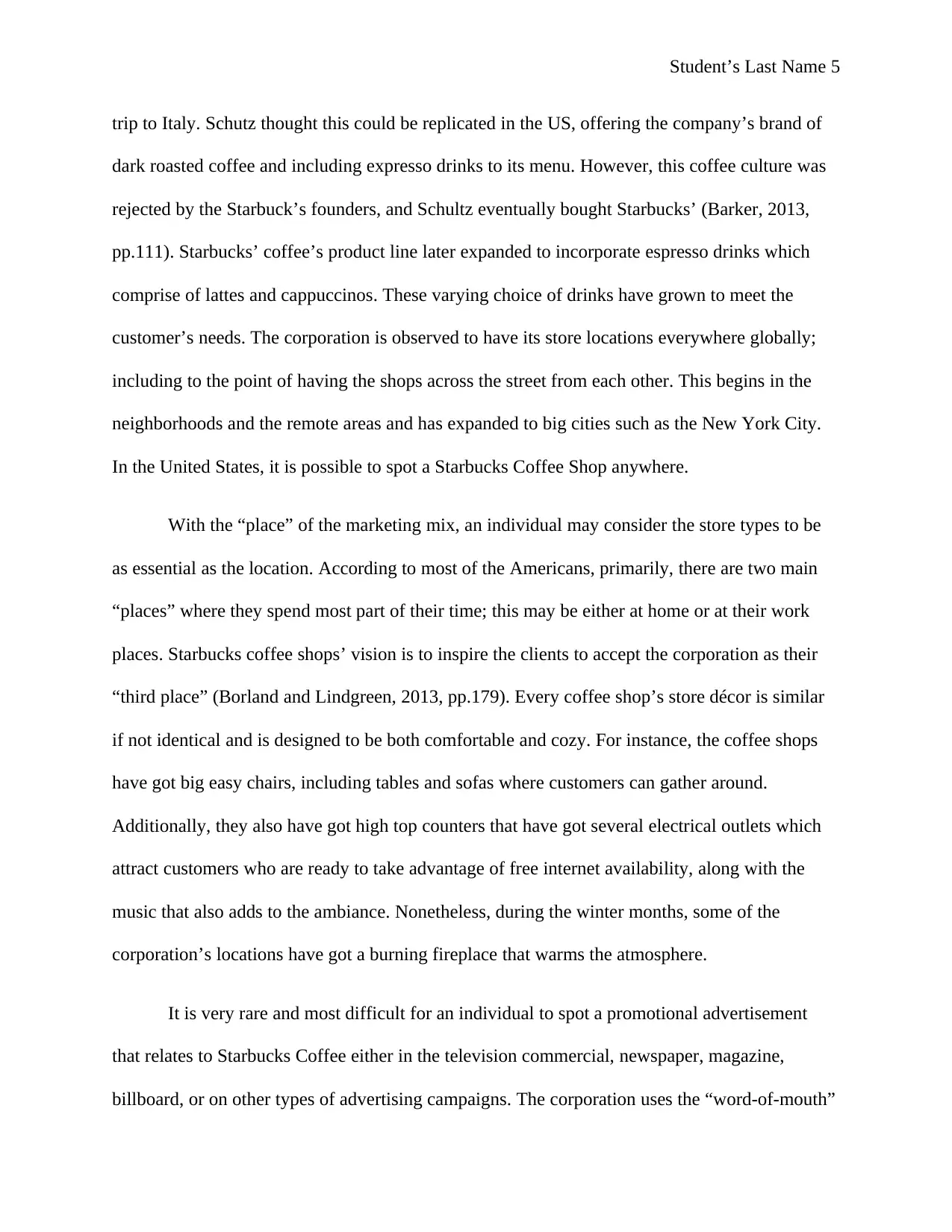
Student’s Last Name 5
trip to Italy. Schutz thought this could be replicated in the US, offering the company’s brand of
dark roasted coffee and including expresso drinks to its menu. However, this coffee culture was
rejected by the Starbuck’s founders, and Schultz eventually bought Starbucks’ (Barker, 2013,
pp.111). Starbucks’ coffee’s product line later expanded to incorporate espresso drinks which
comprise of lattes and cappuccinos. These varying choice of drinks have grown to meet the
customer’s needs. The corporation is observed to have its store locations everywhere globally;
including to the point of having the shops across the street from each other. This begins in the
neighborhoods and the remote areas and has expanded to big cities such as the New York City.
In the United States, it is possible to spot a Starbucks Coffee Shop anywhere.
With the “place” of the marketing mix, an individual may consider the store types to be
as essential as the location. According to most of the Americans, primarily, there are two main
“places” where they spend most part of their time; this may be either at home or at their work
places. Starbucks coffee shops’ vision is to inspire the clients to accept the corporation as their
“third place” (Borland and Lindgreen, 2013, pp.179). Every coffee shop’s store décor is similar
if not identical and is designed to be both comfortable and cozy. For instance, the coffee shops
have got big easy chairs, including tables and sofas where customers can gather around.
Additionally, they also have got high top counters that have got several electrical outlets which
attract customers who are ready to take advantage of free internet availability, along with the
music that also adds to the ambiance. Nonetheless, during the winter months, some of the
corporation’s locations have got a burning fireplace that warms the atmosphere.
It is very rare and most difficult for an individual to spot a promotional advertisement
that relates to Starbucks Coffee either in the television commercial, newspaper, magazine,
billboard, or on other types of advertising campaigns. The corporation uses the “word-of-mouth”
trip to Italy. Schutz thought this could be replicated in the US, offering the company’s brand of
dark roasted coffee and including expresso drinks to its menu. However, this coffee culture was
rejected by the Starbuck’s founders, and Schultz eventually bought Starbucks’ (Barker, 2013,
pp.111). Starbucks’ coffee’s product line later expanded to incorporate espresso drinks which
comprise of lattes and cappuccinos. These varying choice of drinks have grown to meet the
customer’s needs. The corporation is observed to have its store locations everywhere globally;
including to the point of having the shops across the street from each other. This begins in the
neighborhoods and the remote areas and has expanded to big cities such as the New York City.
In the United States, it is possible to spot a Starbucks Coffee Shop anywhere.
With the “place” of the marketing mix, an individual may consider the store types to be
as essential as the location. According to most of the Americans, primarily, there are two main
“places” where they spend most part of their time; this may be either at home or at their work
places. Starbucks coffee shops’ vision is to inspire the clients to accept the corporation as their
“third place” (Borland and Lindgreen, 2013, pp.179). Every coffee shop’s store décor is similar
if not identical and is designed to be both comfortable and cozy. For instance, the coffee shops
have got big easy chairs, including tables and sofas where customers can gather around.
Additionally, they also have got high top counters that have got several electrical outlets which
attract customers who are ready to take advantage of free internet availability, along with the
music that also adds to the ambiance. Nonetheless, during the winter months, some of the
corporation’s locations have got a burning fireplace that warms the atmosphere.
It is very rare and most difficult for an individual to spot a promotional advertisement
that relates to Starbucks Coffee either in the television commercial, newspaper, magazine,
billboard, or on other types of advertising campaigns. The corporation uses the “word-of-mouth”
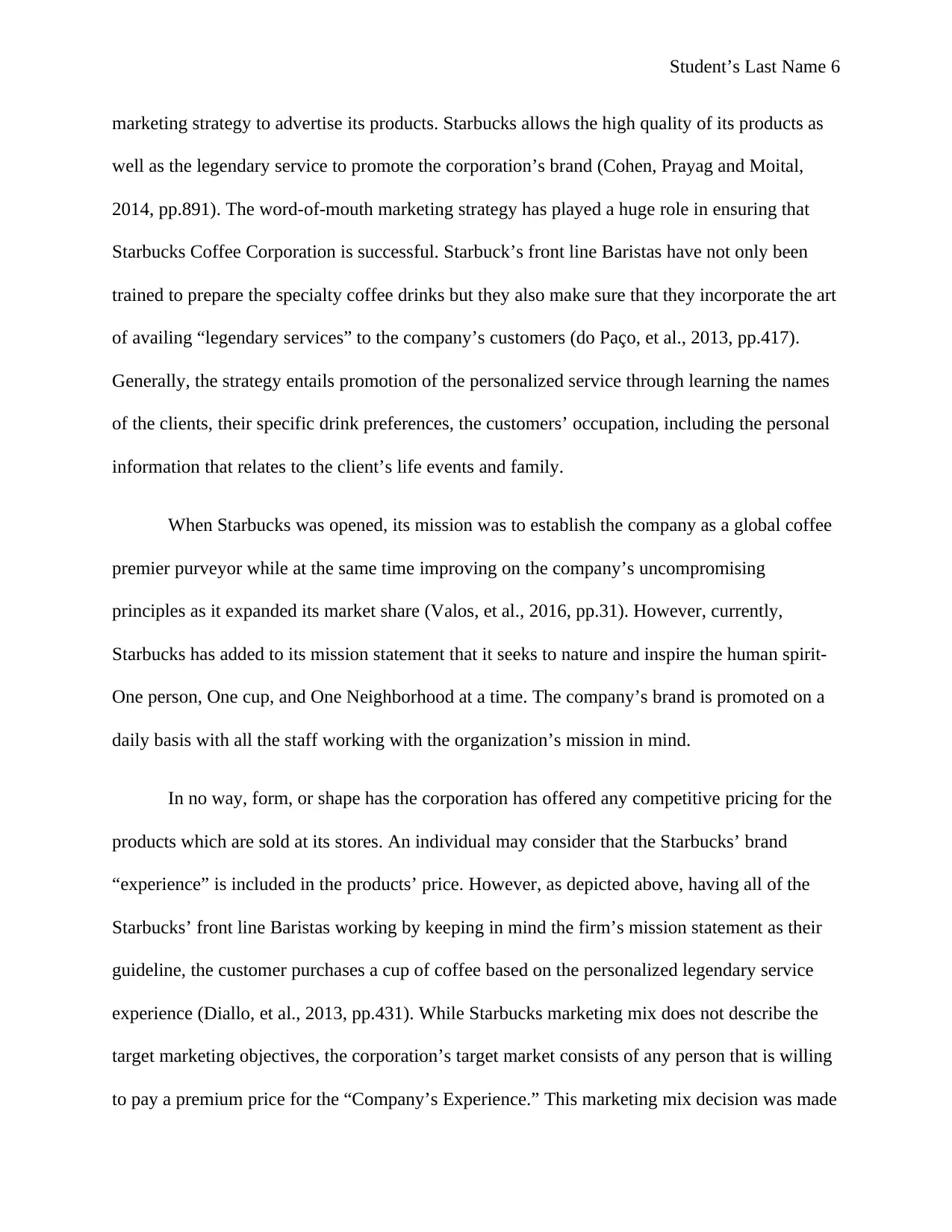
Student’s Last Name 6
marketing strategy to advertise its products. Starbucks allows the high quality of its products as
well as the legendary service to promote the corporation’s brand (Cohen, Prayag and Moital,
2014, pp.891). The word-of-mouth marketing strategy has played a huge role in ensuring that
Starbucks Coffee Corporation is successful. Starbuck’s front line Baristas have not only been
trained to prepare the specialty coffee drinks but they also make sure that they incorporate the art
of availing “legendary services” to the company’s customers (do Paço, et al., 2013, pp.417).
Generally, the strategy entails promotion of the personalized service through learning the names
of the clients, their specific drink preferences, the customers’ occupation, including the personal
information that relates to the client’s life events and family.
When Starbucks was opened, its mission was to establish the company as a global coffee
premier purveyor while at the same time improving on the company’s uncompromising
principles as it expanded its market share (Valos, et al., 2016, pp.31). However, currently,
Starbucks has added to its mission statement that it seeks to nature and inspire the human spirit-
One person, One cup, and One Neighborhood at a time. The company’s brand is promoted on a
daily basis with all the staff working with the organization’s mission in mind.
In no way, form, or shape has the corporation has offered any competitive pricing for the
products which are sold at its stores. An individual may consider that the Starbucks’ brand
“experience” is included in the products’ price. However, as depicted above, having all of the
Starbucks’ front line Baristas working by keeping in mind the firm’s mission statement as their
guideline, the customer purchases a cup of coffee based on the personalized legendary service
experience (Diallo, et al., 2013, pp.431). While Starbucks marketing mix does not describe the
target marketing objectives, the corporation’s target market consists of any person that is willing
to pay a premium price for the “Company’s Experience.” This marketing mix decision was made
marketing strategy to advertise its products. Starbucks allows the high quality of its products as
well as the legendary service to promote the corporation’s brand (Cohen, Prayag and Moital,
2014, pp.891). The word-of-mouth marketing strategy has played a huge role in ensuring that
Starbucks Coffee Corporation is successful. Starbuck’s front line Baristas have not only been
trained to prepare the specialty coffee drinks but they also make sure that they incorporate the art
of availing “legendary services” to the company’s customers (do Paço, et al., 2013, pp.417).
Generally, the strategy entails promotion of the personalized service through learning the names
of the clients, their specific drink preferences, the customers’ occupation, including the personal
information that relates to the client’s life events and family.
When Starbucks was opened, its mission was to establish the company as a global coffee
premier purveyor while at the same time improving on the company’s uncompromising
principles as it expanded its market share (Valos, et al., 2016, pp.31). However, currently,
Starbucks has added to its mission statement that it seeks to nature and inspire the human spirit-
One person, One cup, and One Neighborhood at a time. The company’s brand is promoted on a
daily basis with all the staff working with the organization’s mission in mind.
In no way, form, or shape has the corporation has offered any competitive pricing for the
products which are sold at its stores. An individual may consider that the Starbucks’ brand
“experience” is included in the products’ price. However, as depicted above, having all of the
Starbucks’ front line Baristas working by keeping in mind the firm’s mission statement as their
guideline, the customer purchases a cup of coffee based on the personalized legendary service
experience (Diallo, et al., 2013, pp.431). While Starbucks marketing mix does not describe the
target marketing objectives, the corporation’s target market consists of any person that is willing
to pay a premium price for the “Company’s Experience.” This marketing mix decision was made
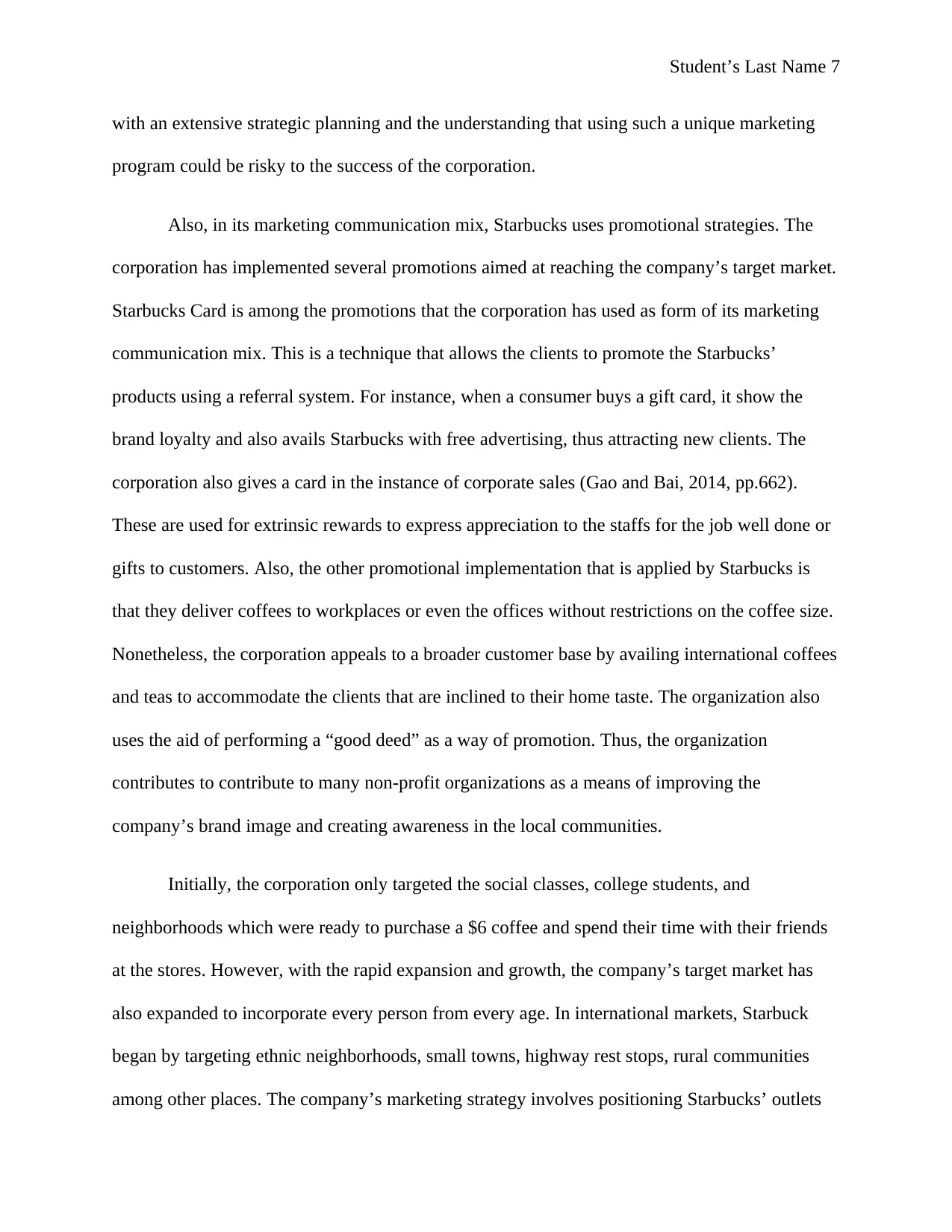
Student’s Last Name 7
with an extensive strategic planning and the understanding that using such a unique marketing
program could be risky to the success of the corporation.
Also, in its marketing communication mix, Starbucks uses promotional strategies. The
corporation has implemented several promotions aimed at reaching the company’s target market.
Starbucks Card is among the promotions that the corporation has used as form of its marketing
communication mix. This is a technique that allows the clients to promote the Starbucks’
products using a referral system. For instance, when a consumer buys a gift card, it show the
brand loyalty and also avails Starbucks with free advertising, thus attracting new clients. The
corporation also gives a card in the instance of corporate sales (Gao and Bai, 2014, pp.662).
These are used for extrinsic rewards to express appreciation to the staffs for the job well done or
gifts to customers. Also, the other promotional implementation that is applied by Starbucks is
that they deliver coffees to workplaces or even the offices without restrictions on the coffee size.
Nonetheless, the corporation appeals to a broader customer base by availing international coffees
and teas to accommodate the clients that are inclined to their home taste. The organization also
uses the aid of performing a “good deed” as a way of promotion. Thus, the organization
contributes to contribute to many non-profit organizations as a means of improving the
company’s brand image and creating awareness in the local communities.
Initially, the corporation only targeted the social classes, college students, and
neighborhoods which were ready to purchase a $6 coffee and spend their time with their friends
at the stores. However, with the rapid expansion and growth, the company’s target market has
also expanded to incorporate every person from every age. In international markets, Starbuck
began by targeting ethnic neighborhoods, small towns, highway rest stops, rural communities
among other places. The company’s marketing strategy involves positioning Starbucks’ outlets
with an extensive strategic planning and the understanding that using such a unique marketing
program could be risky to the success of the corporation.
Also, in its marketing communication mix, Starbucks uses promotional strategies. The
corporation has implemented several promotions aimed at reaching the company’s target market.
Starbucks Card is among the promotions that the corporation has used as form of its marketing
communication mix. This is a technique that allows the clients to promote the Starbucks’
products using a referral system. For instance, when a consumer buys a gift card, it show the
brand loyalty and also avails Starbucks with free advertising, thus attracting new clients. The
corporation also gives a card in the instance of corporate sales (Gao and Bai, 2014, pp.662).
These are used for extrinsic rewards to express appreciation to the staffs for the job well done or
gifts to customers. Also, the other promotional implementation that is applied by Starbucks is
that they deliver coffees to workplaces or even the offices without restrictions on the coffee size.
Nonetheless, the corporation appeals to a broader customer base by availing international coffees
and teas to accommodate the clients that are inclined to their home taste. The organization also
uses the aid of performing a “good deed” as a way of promotion. Thus, the organization
contributes to contribute to many non-profit organizations as a means of improving the
company’s brand image and creating awareness in the local communities.
Initially, the corporation only targeted the social classes, college students, and
neighborhoods which were ready to purchase a $6 coffee and spend their time with their friends
at the stores. However, with the rapid expansion and growth, the company’s target market has
also expanded to incorporate every person from every age. In international markets, Starbuck
began by targeting ethnic neighborhoods, small towns, highway rest stops, rural communities
among other places. The company’s marketing strategy involves positioning Starbucks’ outlets
Paraphrase This Document
Need a fresh take? Get an instant paraphrase of this document with our AI Paraphraser
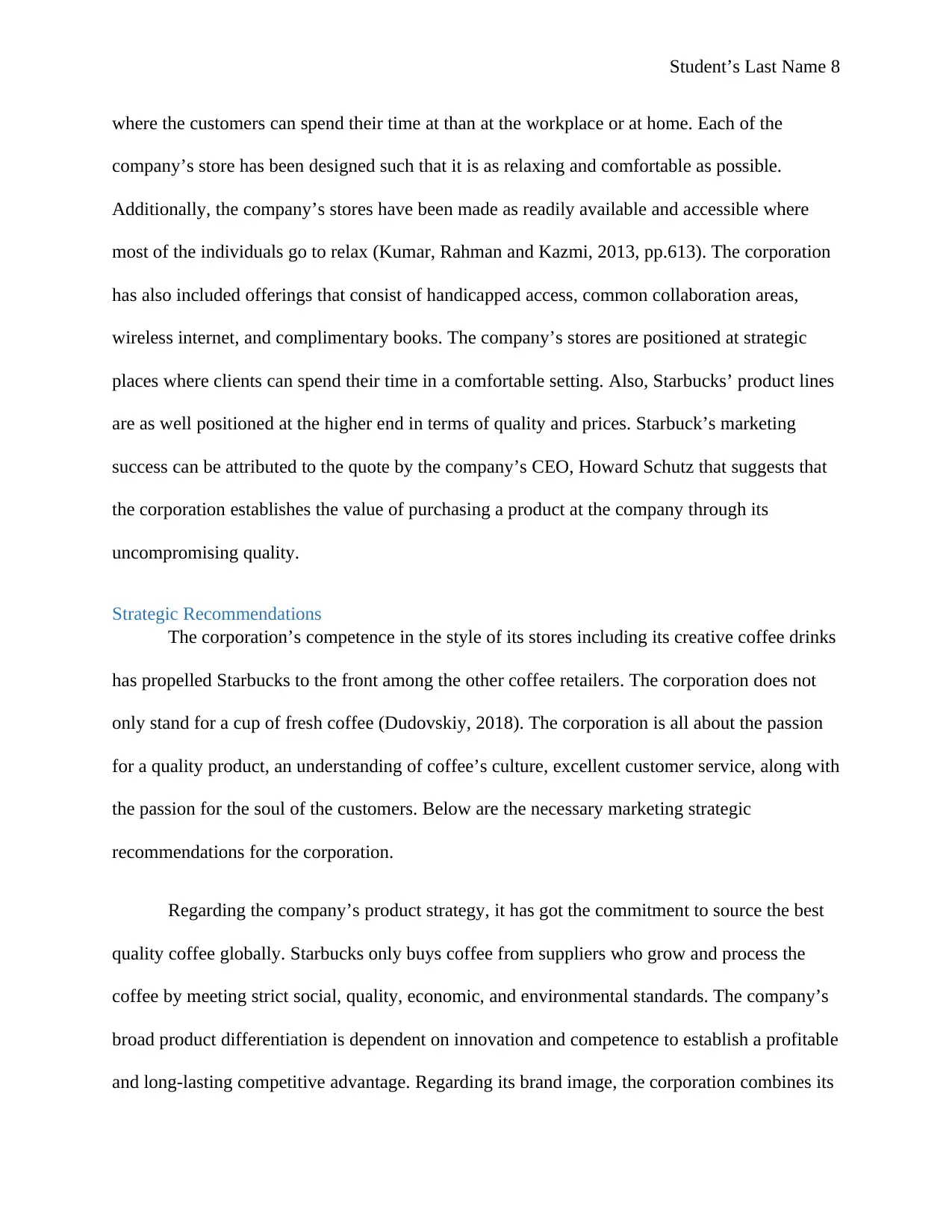
Student’s Last Name 8
where the customers can spend their time at than at the workplace or at home. Each of the
company’s store has been designed such that it is as relaxing and comfortable as possible.
Additionally, the company’s stores have been made as readily available and accessible where
most of the individuals go to relax (Kumar, Rahman and Kazmi, 2013, pp.613). The corporation
has also included offerings that consist of handicapped access, common collaboration areas,
wireless internet, and complimentary books. The company’s stores are positioned at strategic
places where clients can spend their time in a comfortable setting. Also, Starbucks’ product lines
are as well positioned at the higher end in terms of quality and prices. Starbuck’s marketing
success can be attributed to the quote by the company’s CEO, Howard Schutz that suggests that
the corporation establishes the value of purchasing a product at the company through its
uncompromising quality.
Strategic Recommendations
The corporation’s competence in the style of its stores including its creative coffee drinks
has propelled Starbucks to the front among the other coffee retailers. The corporation does not
only stand for a cup of fresh coffee (Dudovskiy, 2018). The corporation is all about the passion
for a quality product, an understanding of coffee’s culture, excellent customer service, along with
the passion for the soul of the customers. Below are the necessary marketing strategic
recommendations for the corporation.
Regarding the company’s product strategy, it has got the commitment to source the best
quality coffee globally. Starbucks only buys coffee from suppliers who grow and process the
coffee by meeting strict social, quality, economic, and environmental standards. The company’s
broad product differentiation is dependent on innovation and competence to establish a profitable
and long-lasting competitive advantage. Regarding its brand image, the corporation combines its
where the customers can spend their time at than at the workplace or at home. Each of the
company’s store has been designed such that it is as relaxing and comfortable as possible.
Additionally, the company’s stores have been made as readily available and accessible where
most of the individuals go to relax (Kumar, Rahman and Kazmi, 2013, pp.613). The corporation
has also included offerings that consist of handicapped access, common collaboration areas,
wireless internet, and complimentary books. The company’s stores are positioned at strategic
places where clients can spend their time in a comfortable setting. Also, Starbucks’ product lines
are as well positioned at the higher end in terms of quality and prices. Starbuck’s marketing
success can be attributed to the quote by the company’s CEO, Howard Schutz that suggests that
the corporation establishes the value of purchasing a product at the company through its
uncompromising quality.
Strategic Recommendations
The corporation’s competence in the style of its stores including its creative coffee drinks
has propelled Starbucks to the front among the other coffee retailers. The corporation does not
only stand for a cup of fresh coffee (Dudovskiy, 2018). The corporation is all about the passion
for a quality product, an understanding of coffee’s culture, excellent customer service, along with
the passion for the soul of the customers. Below are the necessary marketing strategic
recommendations for the corporation.
Regarding the company’s product strategy, it has got the commitment to source the best
quality coffee globally. Starbucks only buys coffee from suppliers who grow and process the
coffee by meeting strict social, quality, economic, and environmental standards. The company’s
broad product differentiation is dependent on innovation and competence to establish a profitable
and long-lasting competitive advantage. Regarding its brand image, the corporation combines its
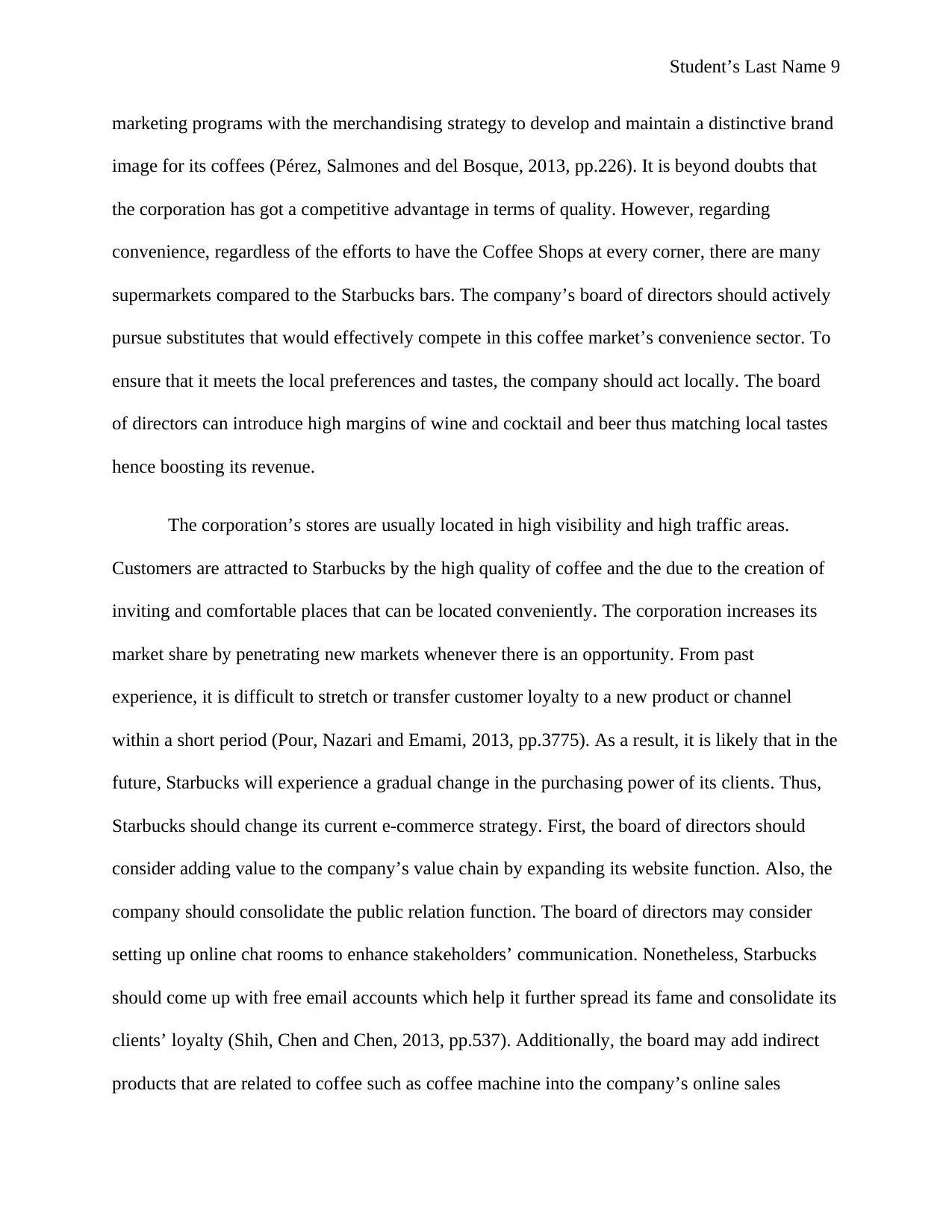
Student’s Last Name 9
marketing programs with the merchandising strategy to develop and maintain a distinctive brand
image for its coffees (Pérez, Salmones and del Bosque, 2013, pp.226). It is beyond doubts that
the corporation has got a competitive advantage in terms of quality. However, regarding
convenience, regardless of the efforts to have the Coffee Shops at every corner, there are many
supermarkets compared to the Starbucks bars. The company’s board of directors should actively
pursue substitutes that would effectively compete in this coffee market’s convenience sector. To
ensure that it meets the local preferences and tastes, the company should act locally. The board
of directors can introduce high margins of wine and cocktail and beer thus matching local tastes
hence boosting its revenue.
The corporation’s stores are usually located in high visibility and high traffic areas.
Customers are attracted to Starbucks by the high quality of coffee and the due to the creation of
inviting and comfortable places that can be located conveniently. The corporation increases its
market share by penetrating new markets whenever there is an opportunity. From past
experience, it is difficult to stretch or transfer customer loyalty to a new product or channel
within a short period (Pour, Nazari and Emami, 2013, pp.3775). As a result, it is likely that in the
future, Starbucks will experience a gradual change in the purchasing power of its clients. Thus,
Starbucks should change its current e-commerce strategy. First, the board of directors should
consider adding value to the company’s value chain by expanding its website function. Also, the
company should consolidate the public relation function. The board of directors may consider
setting up online chat rooms to enhance stakeholders’ communication. Nonetheless, Starbucks
should come up with free email accounts which help it further spread its fame and consolidate its
clients’ loyalty (Shih, Chen and Chen, 2013, pp.537). Additionally, the board may add indirect
products that are related to coffee such as coffee machine into the company’s online sales
marketing programs with the merchandising strategy to develop and maintain a distinctive brand
image for its coffees (Pérez, Salmones and del Bosque, 2013, pp.226). It is beyond doubts that
the corporation has got a competitive advantage in terms of quality. However, regarding
convenience, regardless of the efforts to have the Coffee Shops at every corner, there are many
supermarkets compared to the Starbucks bars. The company’s board of directors should actively
pursue substitutes that would effectively compete in this coffee market’s convenience sector. To
ensure that it meets the local preferences and tastes, the company should act locally. The board
of directors can introduce high margins of wine and cocktail and beer thus matching local tastes
hence boosting its revenue.
The corporation’s stores are usually located in high visibility and high traffic areas.
Customers are attracted to Starbucks by the high quality of coffee and the due to the creation of
inviting and comfortable places that can be located conveniently. The corporation increases its
market share by penetrating new markets whenever there is an opportunity. From past
experience, it is difficult to stretch or transfer customer loyalty to a new product or channel
within a short period (Pour, Nazari and Emami, 2013, pp.3775). As a result, it is likely that in the
future, Starbucks will experience a gradual change in the purchasing power of its clients. Thus,
Starbucks should change its current e-commerce strategy. First, the board of directors should
consider adding value to the company’s value chain by expanding its website function. Also, the
company should consolidate the public relation function. The board of directors may consider
setting up online chat rooms to enhance stakeholders’ communication. Nonetheless, Starbucks
should come up with free email accounts which help it further spread its fame and consolidate its
clients’ loyalty (Shih, Chen and Chen, 2013, pp.537). Additionally, the board may add indirect
products that are related to coffee such as coffee machine into the company’s online sales
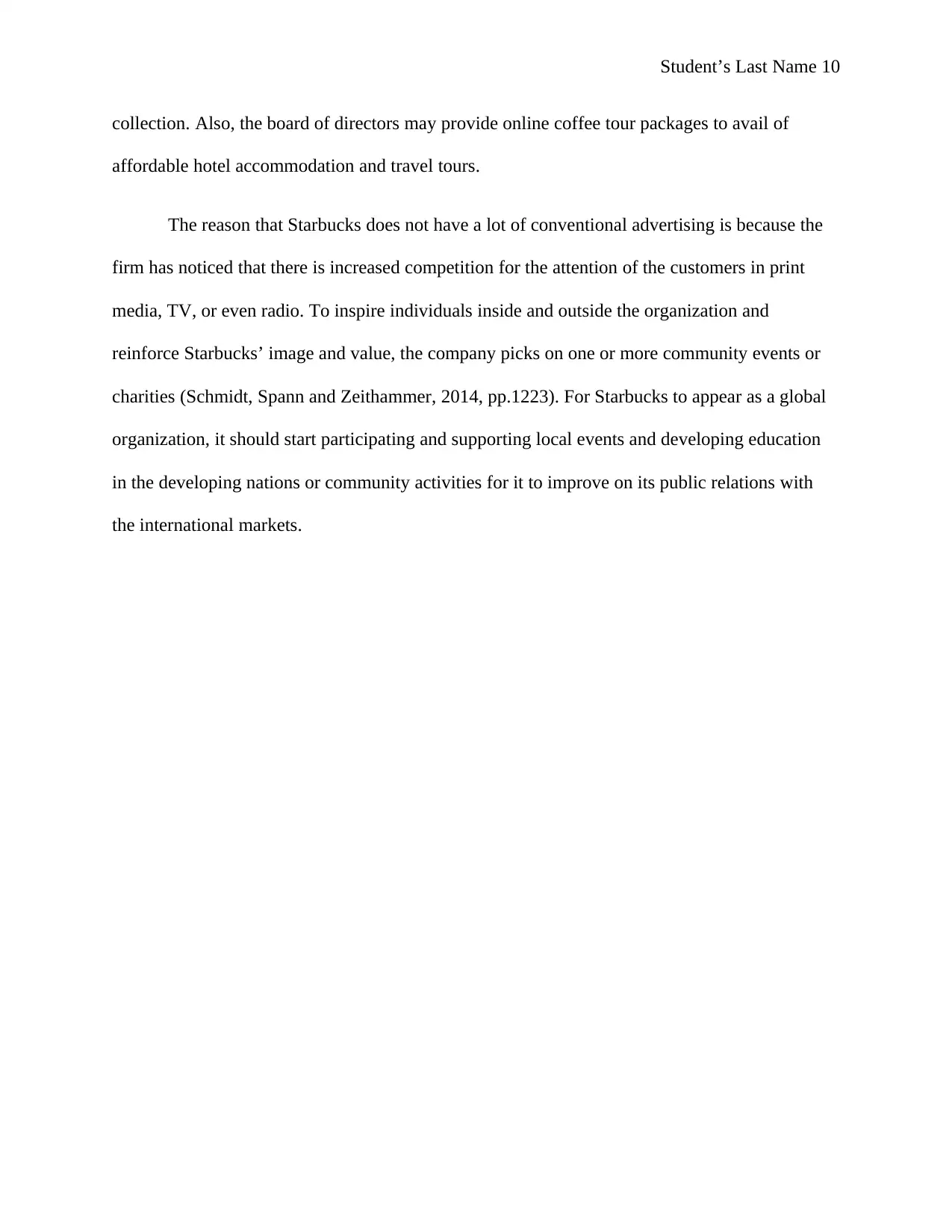
Student’s Last Name 10
collection. Also, the board of directors may provide online coffee tour packages to avail of
affordable hotel accommodation and travel tours.
The reason that Starbucks does not have a lot of conventional advertising is because the
firm has noticed that there is increased competition for the attention of the customers in print
media, TV, or even radio. To inspire individuals inside and outside the organization and
reinforce Starbucks’ image and value, the company picks on one or more community events or
charities (Schmidt, Spann and Zeithammer, 2014, pp.1223). For Starbucks to appear as a global
organization, it should start participating and supporting local events and developing education
in the developing nations or community activities for it to improve on its public relations with
the international markets.
collection. Also, the board of directors may provide online coffee tour packages to avail of
affordable hotel accommodation and travel tours.
The reason that Starbucks does not have a lot of conventional advertising is because the
firm has noticed that there is increased competition for the attention of the customers in print
media, TV, or even radio. To inspire individuals inside and outside the organization and
reinforce Starbucks’ image and value, the company picks on one or more community events or
charities (Schmidt, Spann and Zeithammer, 2014, pp.1223). For Starbucks to appear as a global
organization, it should start participating and supporting local events and developing education
in the developing nations or community activities for it to improve on its public relations with
the international markets.
Secure Best Marks with AI Grader
Need help grading? Try our AI Grader for instant feedback on your assignments.
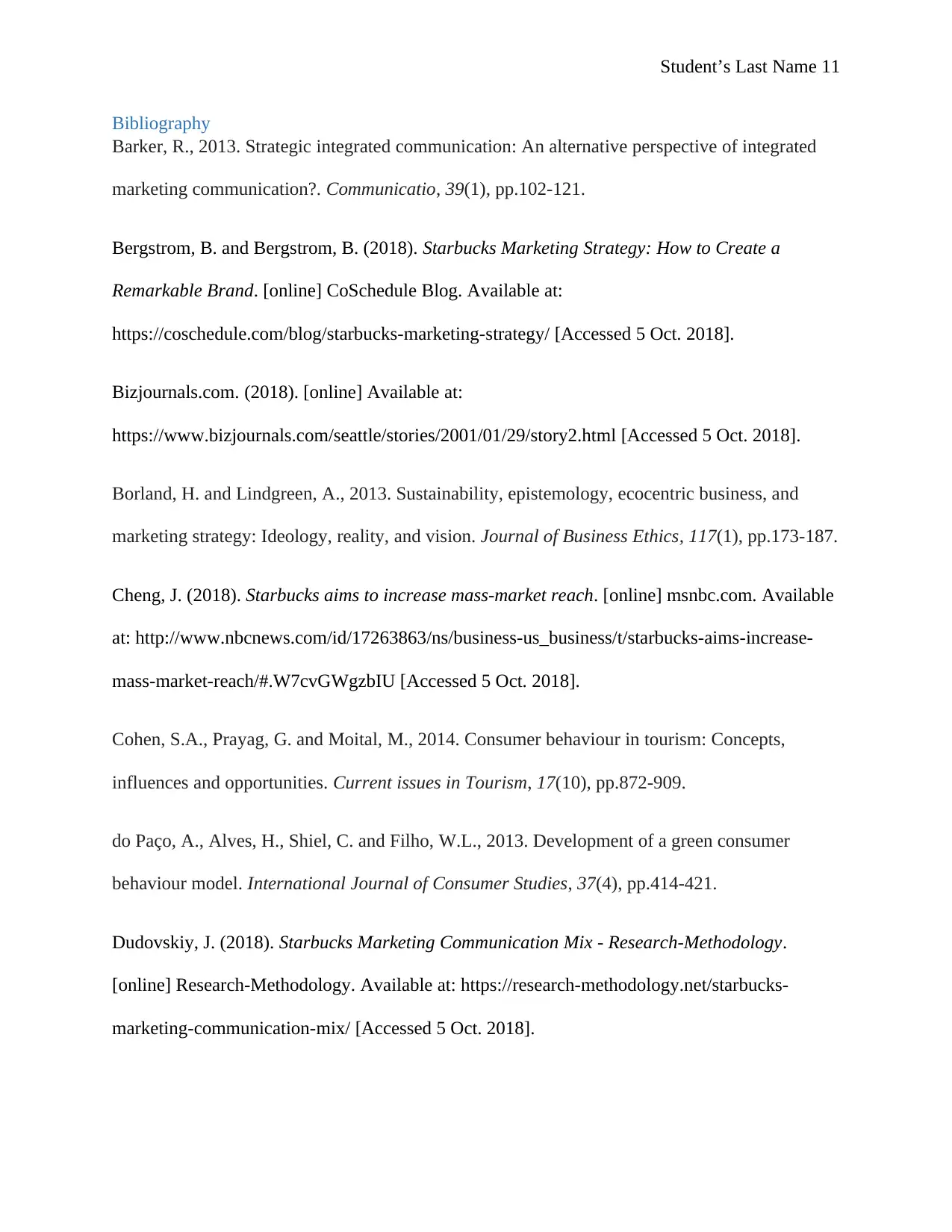
Student’s Last Name 11
Bibliography
Barker, R., 2013. Strategic integrated communication: An alternative perspective of integrated
marketing communication?. Communicatio, 39(1), pp.102-121.
Bergstrom, B. and Bergstrom, B. (2018). Starbucks Marketing Strategy: How to Create a
Remarkable Brand. [online] CoSchedule Blog. Available at:
https://coschedule.com/blog/starbucks-marketing-strategy/ [Accessed 5 Oct. 2018].
Bizjournals.com. (2018). [online] Available at:
https://www.bizjournals.com/seattle/stories/2001/01/29/story2.html [Accessed 5 Oct. 2018].
Borland, H. and Lindgreen, A., 2013. Sustainability, epistemology, ecocentric business, and
marketing strategy: Ideology, reality, and vision. Journal of Business Ethics, 117(1), pp.173-187.
Cheng, J. (2018). Starbucks aims to increase mass-market reach. [online] msnbc.com. Available
at: http://www.nbcnews.com/id/17263863/ns/business-us_business/t/starbucks-aims-increase-
mass-market-reach/#.W7cvGWgzbIU [Accessed 5 Oct. 2018].
Cohen, S.A., Prayag, G. and Moital, M., 2014. Consumer behaviour in tourism: Concepts,
influences and opportunities. Current issues in Tourism, 17(10), pp.872-909.
do Paço, A., Alves, H., Shiel, C. and Filho, W.L., 2013. Development of a green consumer
behaviour model. International Journal of Consumer Studies, 37(4), pp.414-421.
Dudovskiy, J. (2018). Starbucks Marketing Communication Mix - Research-Methodology.
[online] Research-Methodology. Available at: https://research-methodology.net/starbucks-
marketing-communication-mix/ [Accessed 5 Oct. 2018].
Bibliography
Barker, R., 2013. Strategic integrated communication: An alternative perspective of integrated
marketing communication?. Communicatio, 39(1), pp.102-121.
Bergstrom, B. and Bergstrom, B. (2018). Starbucks Marketing Strategy: How to Create a
Remarkable Brand. [online] CoSchedule Blog. Available at:
https://coschedule.com/blog/starbucks-marketing-strategy/ [Accessed 5 Oct. 2018].
Bizjournals.com. (2018). [online] Available at:
https://www.bizjournals.com/seattle/stories/2001/01/29/story2.html [Accessed 5 Oct. 2018].
Borland, H. and Lindgreen, A., 2013. Sustainability, epistemology, ecocentric business, and
marketing strategy: Ideology, reality, and vision. Journal of Business Ethics, 117(1), pp.173-187.
Cheng, J. (2018). Starbucks aims to increase mass-market reach. [online] msnbc.com. Available
at: http://www.nbcnews.com/id/17263863/ns/business-us_business/t/starbucks-aims-increase-
mass-market-reach/#.W7cvGWgzbIU [Accessed 5 Oct. 2018].
Cohen, S.A., Prayag, G. and Moital, M., 2014. Consumer behaviour in tourism: Concepts,
influences and opportunities. Current issues in Tourism, 17(10), pp.872-909.
do Paço, A., Alves, H., Shiel, C. and Filho, W.L., 2013. Development of a green consumer
behaviour model. International Journal of Consumer Studies, 37(4), pp.414-421.
Dudovskiy, J. (2018). Starbucks Marketing Communication Mix - Research-Methodology.
[online] Research-Methodology. Available at: https://research-methodology.net/starbucks-
marketing-communication-mix/ [Accessed 5 Oct. 2018].
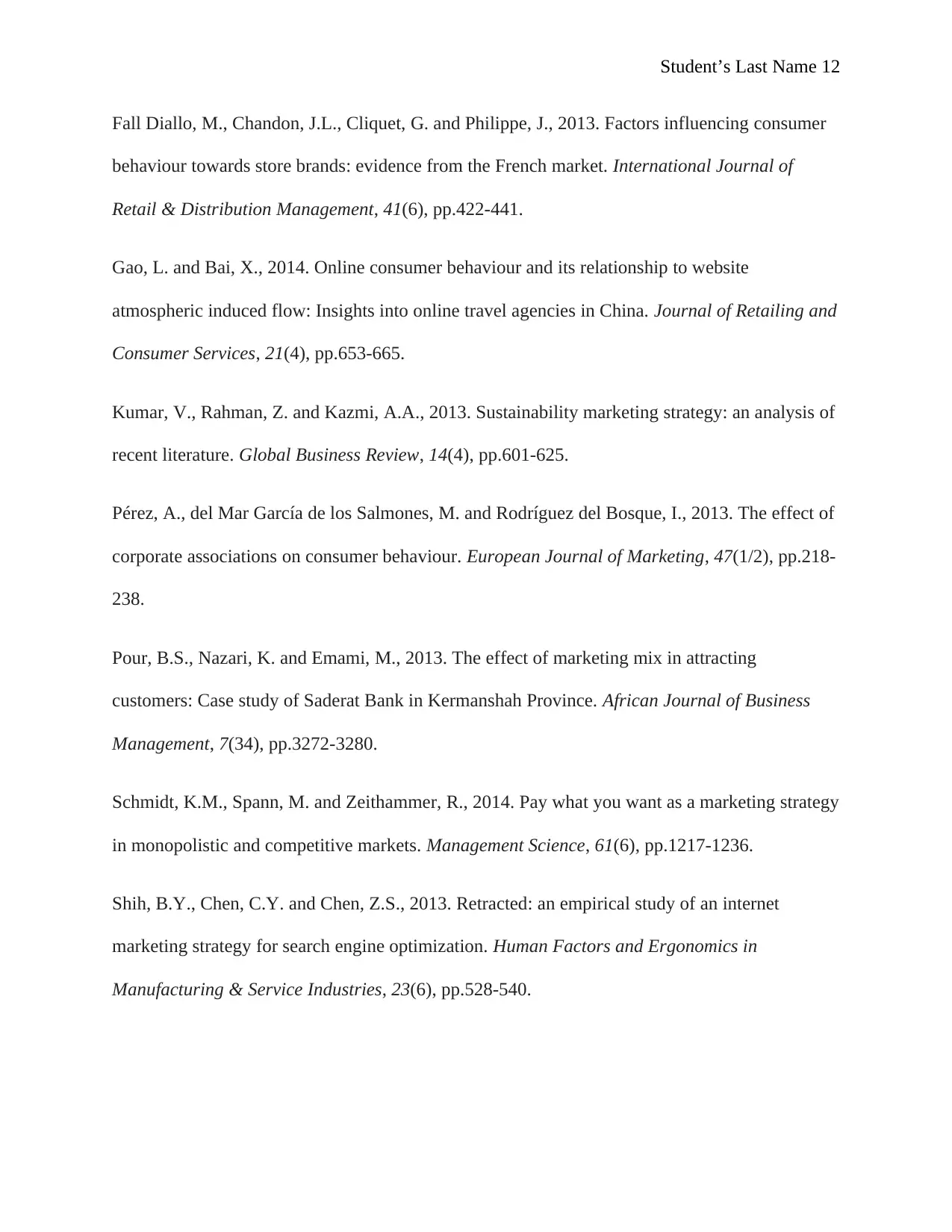
Student’s Last Name 12
Fall Diallo, M., Chandon, J.L., Cliquet, G. and Philippe, J., 2013. Factors influencing consumer
behaviour towards store brands: evidence from the French market. International Journal of
Retail & Distribution Management, 41(6), pp.422-441.
Gao, L. and Bai, X., 2014. Online consumer behaviour and its relationship to website
atmospheric induced flow: Insights into online travel agencies in China. Journal of Retailing and
Consumer Services, 21(4), pp.653-665.
Kumar, V., Rahman, Z. and Kazmi, A.A., 2013. Sustainability marketing strategy: an analysis of
recent literature. Global Business Review, 14(4), pp.601-625.
Pérez, A., del Mar García de los Salmones, M. and Rodríguez del Bosque, I., 2013. The effect of
corporate associations on consumer behaviour. European Journal of Marketing, 47(1/2), pp.218-
238.
Pour, B.S., Nazari, K. and Emami, M., 2013. The effect of marketing mix in attracting
customers: Case study of Saderat Bank in Kermanshah Province. African Journal of Business
Management, 7(34), pp.3272-3280.
Schmidt, K.M., Spann, M. and Zeithammer, R., 2014. Pay what you want as a marketing strategy
in monopolistic and competitive markets. Management Science, 61(6), pp.1217-1236.
Shih, B.Y., Chen, C.Y. and Chen, Z.S., 2013. Retracted: an empirical study of an internet
marketing strategy for search engine optimization. Human Factors and Ergonomics in
Manufacturing & Service Industries, 23(6), pp.528-540.
Fall Diallo, M., Chandon, J.L., Cliquet, G. and Philippe, J., 2013. Factors influencing consumer
behaviour towards store brands: evidence from the French market. International Journal of
Retail & Distribution Management, 41(6), pp.422-441.
Gao, L. and Bai, X., 2014. Online consumer behaviour and its relationship to website
atmospheric induced flow: Insights into online travel agencies in China. Journal of Retailing and
Consumer Services, 21(4), pp.653-665.
Kumar, V., Rahman, Z. and Kazmi, A.A., 2013. Sustainability marketing strategy: an analysis of
recent literature. Global Business Review, 14(4), pp.601-625.
Pérez, A., del Mar García de los Salmones, M. and Rodríguez del Bosque, I., 2013. The effect of
corporate associations on consumer behaviour. European Journal of Marketing, 47(1/2), pp.218-
238.
Pour, B.S., Nazari, K. and Emami, M., 2013. The effect of marketing mix in attracting
customers: Case study of Saderat Bank in Kermanshah Province. African Journal of Business
Management, 7(34), pp.3272-3280.
Schmidt, K.M., Spann, M. and Zeithammer, R., 2014. Pay what you want as a marketing strategy
in monopolistic and competitive markets. Management Science, 61(6), pp.1217-1236.
Shih, B.Y., Chen, C.Y. and Chen, Z.S., 2013. Retracted: an empirical study of an internet
marketing strategy for search engine optimization. Human Factors and Ergonomics in
Manufacturing & Service Industries, 23(6), pp.528-540.
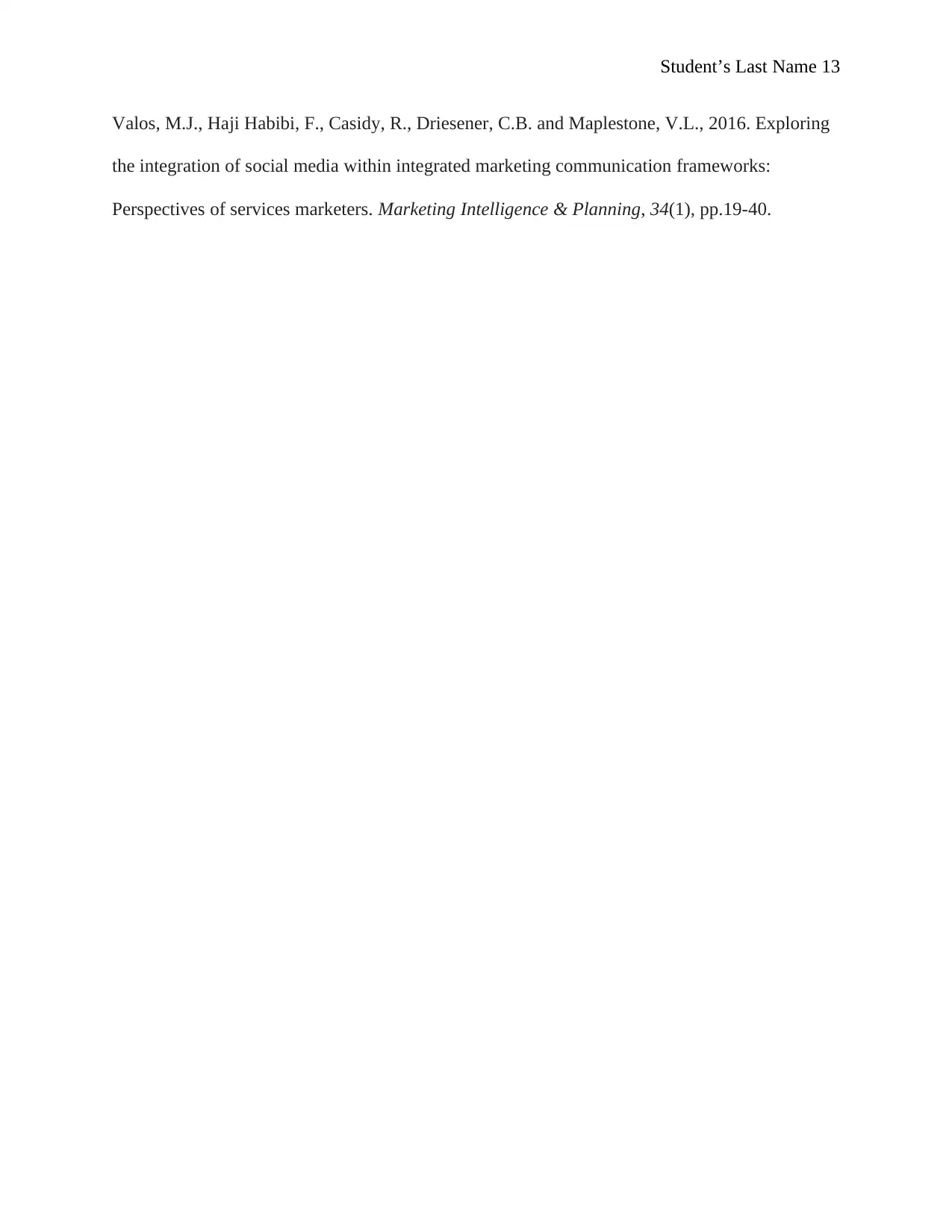
Student’s Last Name 13
Valos, M.J., Haji Habibi, F., Casidy, R., Driesener, C.B. and Maplestone, V.L., 2016. Exploring
the integration of social media within integrated marketing communication frameworks:
Perspectives of services marketers. Marketing Intelligence & Planning, 34(1), pp.19-40.
Valos, M.J., Haji Habibi, F., Casidy, R., Driesener, C.B. and Maplestone, V.L., 2016. Exploring
the integration of social media within integrated marketing communication frameworks:
Perspectives of services marketers. Marketing Intelligence & Planning, 34(1), pp.19-40.
1 out of 13
Related Documents
Your All-in-One AI-Powered Toolkit for Academic Success.
+13062052269
info@desklib.com
Available 24*7 on WhatsApp / Email
![[object Object]](/_next/static/media/star-bottom.7253800d.svg)
Unlock your academic potential
© 2024 | Zucol Services PVT LTD | All rights reserved.





